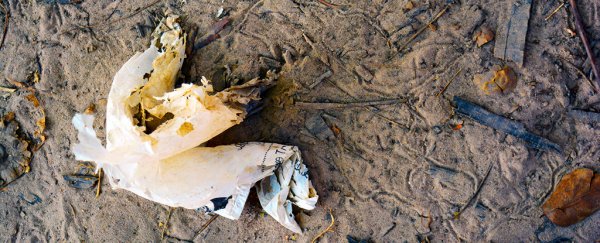There's no doubt we have too much plastic in our oceans, and it's all our fault.
But an unexpected source of support might help us to solve this terrible environmental problem: marine microbes that eat plastic, breaking the ubiquitous waste material down.
In new research, an international team of scientists studied how microbial communities build up on ocean-polluting plastics and contribute to their degradation – a natural biological mechanism we might be able to exploit, if we can learn to understand it better.
Once plastic enters the ocean, it becomes weathered by a range of non-biological factors, including UV radiation, fluctuating temperatures, and forces of abrasion in the ocean water.
These environmental processes kickstart the material's devolution into fragments of ever smaller microplastics and nanoplastics - but the stressors don't act alone.
"Abiotic degradation precedes and stimulates biodegradation since carbonyl groups are generated on the [plastic] surface," the researchers, led by environmental engineer Evdokia Syranidou from the Technical University of Crete in Greece, explain in their paper.
"Therefore, a wide range of organisms can settle on the weathered surface, using it as a substrate and as a carbon source."
To study how efficient this microbial munching is in terms of breaking plastics down further, the researchers collected samples of naturally weathered polyethylene (PE) and polystyrene (PS) debris from two beaches in Greece.
Having been washed and then cut up into small pieces, the plastic fragments were dunked in a saline solution which acted as an ocean water proxy.
They were then exposed to two different kinds of microbial communities: naturally occurring organisms indigenous to the sea (comprising several different species), and bio-augmented strains tweaked to form stronger biofilms on plastic surfaces.
After five months of microbial exposure, the plastic pieces were weighed, revealing that the indigenous organisms had succeeded in reducing the weight of weathered PS by up to 11 percent, and weathered PE by up to 7 percent.
The bioengineered strain didn't eat as much plastic, although the team noted that it "seems more efficient in adhering to the weathered pieces and developing a biofilm community" of greater abundance.
Tellingly, the most successful results by far were from an experiment that used "acclimated microbes" – organisms already exposed to the plastics in an earlier simulation.
In other words, it looks like these things may develop a taste for plastics, and get better at eating them with time.
In addition to munching through the plastic, the microbial exposure also resulted in chemical changes to the materials' surface, producing carbonyl groups and double bonds, and revealing processes such as chain scission as they affected the plastic at the molecular level.
This definitely isn't the first time scientists have looked into harnessing the power of microbes to help us deal with our plastic problems.
For years, researchers have investigated how organisms might be able to eat our plastic waste.
Every breakthrough we make, no matter how small, could help with clean-up efforts one day – even if the biggest fix is to tackle the problem at the source.
Until that happens, though – and society finds a way to stop producing this waste in such devastating volume – there's a lot we stand to gain by learning more about microbial munching, and finding a way to harness it.
"Closing the gap between the hypothetic and realistic employment of microbial networks for plastic degradation could contribute to the development of mitigation measures and sustainable policies," the team writes.
The findings are reported in Journal of Hazardous Materials.
